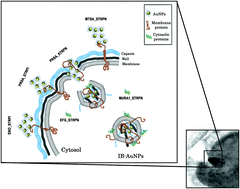Antibacterial mechanism of gold nanoparticles on Streptococcus pneumoniae†
Abstract
Streptococcus pneumoniae is a causal agent of otitis media, pneumonia, meningitis and severe cases of septicemia. This human pathogen infects elderly people and children with a high mortality rate of approximately one million deaths per year worldwide. Antibiotic-resistance of S. pneumoniae strains is an increasingly serious health problem; therefore, new therapies capable of combating pneumococcal infections are indispensable. The application of gold nanoparticles has emerged as an option in the control of bacterial infections; however, the mechanism responsible for bacterial cell lysis remains unclear. Specifically, it has been observed that gold nanoparticles are capable of crossing different structures of the S. pneumoniae cells, reaching the cytosol where inclusion bodies of gold nanoparticles are noticed. In this work, a novel process for the separation of such inclusion bodies that allowed the analysis of the biomolecules such as carbohydrates, lipids and proteins associated with the gold nanoparticles was developed. Then, it was possible to separate and identify proteins associated with the gold nanoparticles, which were suggested as possible candidates that facilitate the interaction and entry of gold nanoparticles into S. pneumoniae cells.



 Please wait while we load your content...
Please wait while we load your content...